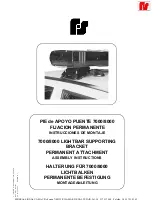
«RIELTA», JSC www.rielta.ru
Chapaeva Str. 17, Saint Petersburg 197101, Russian Federation,
E-mail: [email protected]
Tel/fax: +7 (812) 233-0302, 703-1360,
Technical support, tel. +7 (812) 233-29-53, 703-13-57, [email protected]
Wall mounting of the
swivel
Ceiling mounting of the
swivel
For wall
mounting
Rear housing latch access
For corner mounting
Blind flanges for the
wiring openings
For mounting rear
housing on a
s
wivel
Sensor rear housing
Сircuit board latch
Swivel
Buushing
Sphere
Screw
Details of the swivel bracket
Figure 2 – Sensor rear housing and swivel bracket
5.3 For the best quality video image production, it is recommended to
take into account the following requirements:
- avoid direct flash exposurers of TV-camera lens;
- prevent the installation of sourses of light sources alongside of the
Detector in order to avoid hot spots on the lens;
- under operation at a night-time, it is necessary to apply additional
light sources.
5.4 In case of installation of the Detector without swivel bracket, the
recommended installation height is 2.3 m from the floor. Therewith, the
PIR-channel detection range is not less than 12 m.
ATTENTION!
In this variant of installation the sabotage protection zone
of PIR-channel is not caught on TV-camera. When TV-camera monitoring
of sabotage protection zone is required it is recommended to incline the
Detector down over 300 with respect to norm position. For this purpose, the
Detector should be installed on the swivel bracket. Note that this method
of installation reduces the detection zone as little as 4 m.
5.5 Fulfill the Detector installation in the following sequence:
- Preliminarily choose the place of installation (taking into account
specification described in Cls.5.3, 5.4);
- Using flat tip screwdriver put off the cover by pressing the latch of
the cover throuh the opening located on the case bottom; (See Figure 2);
- Put off the PCB by unfastening the PCB fixing arm;
- Set up the DIP switches in accordance with chosen operation algorithm
(See Cl.6.1);
- Drill holes in the base for the Detector wiring and fastening the base;
- Choose the place of installation, mark the places for mounting holes
with regard to the openings on the detector base(swivel bracket), drill
holes in the wall;
- Pass the wires through the wiring holes in the base, leaving several
centimeters of the wires for connecting them inside the case;
- Fasten the base (swivel bracket) on the chosen place. In case of
installation on the swivel bracket, move the screw upwards and remove it
from the sphere, align the squere bulge on the sphere wirh correspondent
recess in the top of the base. Insert a screw into the opening of the base
top, locate the base in the required position, tighten the screw;
- Set up the DIP-switches in accordance with chosen operation algorithm
(See Cl.6.1);
- Install the PCB on its place.
5.6 Connection of the Detector
5.6.1 Terminals for connection of alarm loop, video system and additional
lighting control unit, as well as voltage application terminals are located
on the PCB top.
5.6.2 Fulfill connections in accordance with the pattern, shown in Figure 2.
5.7 Place an announcement at the place ensuring possibility to acquaint
everybody of the audience at the secured object about video control
presence.
6 Preparation for Operation
6.1 DIP-Switches Settings
6.1.1 In order to prepare the Detector for particular exploitation conditions
it is nesessary to set up «1», «2», «3», «4», «5» DIP-switches in relevant
positions in accordance with the Table 2.
Table 2
Mode
DIP-
switch
DIP-switch position
ON
OFF
Sensitivity
«1»
Normal
High
Testing
«2»
Sensivity (sensitivity check)
Detection zone (DZ check)
Indicator
«3»
ON
OFF
TV-camera
mode
«4», «5»
See table 3
6.1.2 DIP-switches «4» and «5» position correspondence to the TV-
camera mode is listed in Table 3.
Table 3
«4»
«5»
TV-camera operation mode
ON
OFF
5 s after alarm
OFF
ON
30 s after alarm
ON
ON
120 s after alarm
OFF
OFF
TV-camera adjustment – periodical TV-camera switching on for
(600±20) s
6.1.3 Testing modes
Upon the warm-up time expiry, the Detector entirely assumes its
functionality. For the Detector checking two testing modes both with 5
min run time are provided.
Detection Zone (DZ) Check Mode
DIP-switches porition: «2» – OFF, «3» – ON. This mode is intended for
each DZ beam position determination. Upon each DZ beam crossing, the
indicator is switched on for 0.25 s. Optimal movement speed at maximal
distance is 0.5 m/s.
Sensitivity Check Mode
DIP-switches position: «2» – ON, «3» – OFF. This mode is intended for
estimation of the Detector sensitivity (the distance covered within the DZ
till the moment of an Alarm message generation). LED indicator switches
for 0.25 s upon each DZ beam crossing, and the LED is lighting for 5 s
displaying an Alarm message transmission.
High sensitivity
– DIP-switch position: «1» – OFF. Main operation
mode. An Alarm message is generated after 2 – 4 steps within the DZ
(after LED indicator single switching for 0.25 s).
Normal sensitivity
– DIP-switch position: «1» – ON. This sensitivity
mode is recommended for usage inside the premises with advanced
interference. An Alarm message is generated after 4 – 5 steps within the
DZ (after LED indicator double switching for 0.25 s). After every Alarm
message generation stop moving and male a pouse till the LED is switched
off, after what wait for 8 – 10 s before resuming movement inside the DZ.
NOTE :
If the detector fails to detect moving objects in the detection
zone, its position on its swivel bracket should be changed (In case of wall
mounting the rotation angle of the Detector in horizontal plane is ±45° and
its tilt degree in vertical plane is not less than 20°)
Under the movement absence in the secured zone, the LED indicator
should not light. After 5 min operation in any of both testing modes the
Detector turns to normal operation mode automatically (in case of «3»
jamper is ON, the alarm message generation is displayed by LED indicator
lighting for 3 s period).
The DZ location can be estimated at-a-glance by transforming TV-
camera to continuous operation mode and by monitoring movements on
video-system control unit.
6.1.4 LED indicator disabling
For the detector operation masking, the LED indication disabling mode
is provided. DIP-switch «3» is OFF. In this mode the LED indicator is
operative only at a first minute after energizing, as well as during «Failure»
message generation.
6.2 To prepare the Detector to operation act as follows:
- check correctness of the Detector installation;
- set up the DIP-switches to the required mode (set up DIP-switches
«4» and «5» to OFF position for adjustment of TV-channel detection zone,
choose sensitivity mode by means of DIP-switch «1»);
- energize the Detector. During 60 s after energizing the LED indicator
should blink at a frequency of 1 Hz, informing about its turning to normal
operation;
- fulfill a simulation of the intruder movement through the DZ at a speed
0.3 m/s, and then 3 m/s monitoring the Detector response by its LED
indicator switching on. It is advisable to repeat such passages at minimal
as well as at maximal distanses to the Detector. Make sure that at the
video-system control unit (hereinafter, VCU) your video image is visible.
Verify that in case of optional lighting circuit control (LCC) it was switched
ON during passages.
- in case of the Detector response failure or your video image absence,
it is necessary to make corrections in the DZ location. In the lack of
illumination, install sufficient illumination devices or additional optional
lighting, controlled by the LCC;
- after adjustment finishing set up the DIP-switches to the operating
mode.




















